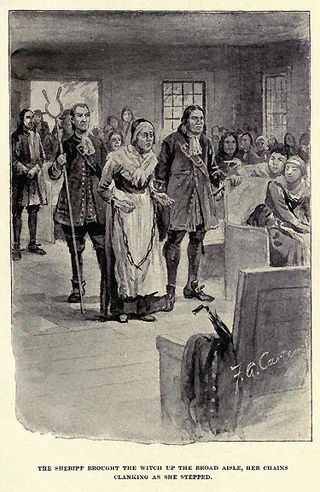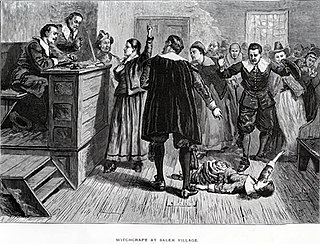Related Research Articles

The Crucible is a 1953 play by the American playwright Arthur Miller. It is a dramatized and partially fictionalized story of the Salem witch trials that took place in the Massachusetts Bay Colony during 1692–93. Miller wrote the play as an allegory for McCarthyism, when the United States government persecuted people accused of being communists. Miller was questioned by the House of Representatives' Committee on Un-American Activities in 1956 and convicted of contempt of Congress for refusing to identify others present at meetings he had attended.

The Salem witch trials were a series of hearings and prosecutions of people accused of witchcraft in colonial Massachusetts between February 1692 and May 1693. More than 200 people were accused. Thirty people were found guilty, nineteen of whom were executed by hanging. One other man, Giles Corey, died under torture after refusing to enter a plea, and at least five people died in jail.
John Proctor was a landowner in the Massachusetts Bay Colony. He and his wife Elizabeth were tried and convicted of witchcraft as part of the Salem Witch Trials, whereupon he was hanged.
Elizabeth Proctor was convicted of witchcraft in the Salem Witch Trials of 1692. She was the wife of John Proctor, who was convicted and executed.

Susannah Martin was one of fourteen women executed for the suspicion of practicing witchcraft during the Salem witch trials of colonial Massachusetts.

Rebecca Nurse was a woman who was accused of witchcraft and executed by hanging in New England during the Salem Witch Trials of 1692. She was fully exonerated fewer than twenty years later.

Ann Pudeator was a wealthy septuagenarian widow who was accused of and convicted of witchcraft in the Salem witch trials in colonial Massachusetts. She was executed by hanging.
This timeline of the Salem witch trials is a quick overview of the events.

Sarah Wildes was wrongly convicted of witchcraft during the Salem witch trials and was executed by hanging. She maintained her innocence throughout the process, and was later exonerated. Her husband's first wife was a member of the Gould family, cousins of the Putnam family, the primary accusers, and court records document the family feuds which led to her persecution.
Abigail Faulkner, sometimes called Abigail Faulkner Sr., was an American woman accused of witchcraft during the Salem witch trials in 1692. In the frenzy that followed, Faulkner's sister Elizabeth (Dane) Johnson (1641–1722), her sister-in-law Deliverance Dane, two of her daughters, two of her nieces, and a nephew, would all be accused of witchcraft and arrested. Faulkner was convicted and sentenced to death, but her execution was delayed due to pregnancy. Before she gave birth, Faulkner was pardoned by the governor and released from prison.

Ann Hibbins was a woman executed for witchcraft in Boston, Massachusetts Bay Colony, on June 19, 1656. Her death by hanging was the third for witchcraft in Boston and predated the Salem witch trials of 1692. Hibbins was later fictionalized in Nathaniel Hawthorne's famous novel The Scarlet Letter. A wealthy widow, Hibbins was the sister-in-law by marriage to Massachusetts governor Richard Bellingham. Her sentence was handed down by Governor John Endicott.
Margaret Jones was the first person to be executed for witchcraft in Massachusetts Bay Colony, and the second in New England during a witch-hunt that lasted from 1647 to 1693. Hundreds of people throughout New England were accused of practicing witchcraft during that period, including over two hundred in 1692 during the Salem Witch Trials. Prior to the Salem Witch Trials of 1692, over a forty-one year period (1647–1688), nine women, including Margaret Jones, were hanged as witches.

Elizabeth Booth was born in 1674 and was one of the accusers in the Salem Witch Trials. She grew up in Salem, Massachusetts, as the second eldest of ten children. When she was sixteen she was accused of being a witch. When she was eighteen, she began accusing people of practicing witchcraft, including John Proctor, Elizabeth Proctor, Sarah Proctor, William Proctor, Benjamin Proctor, Woody Proctor, Giles Corey, Martha Corey, Job Tookey, and Wilmont Redd. Five of these people were executed due to Booth's testimony. Elizabeth Proctor would have been executed as well if she was not pregnant. After the Witch Trials, Booth married Israel Shaw on December 26, 1695, and had two children named Israel and Susanna. Booth's death date is unknown.
The Channel Islands Witch Trials were a series of witch trials in the Channel Islands of Jersey and Guernsey between 1562 and 1661.

Margaret Scott was found guilty of witchcraft during the Salem witch trials and was executed by hanging on September 22, 1692. She was part of the last group to be executed, which also included Mary Eastey, Martha Corey, Ann Pudeator, Samuel Wardwell, Mary Parker, Alice Parker, and Wilmot Redd. She was the only accused person from Rowley to be executed. As a lower-class, long-term widow, having lost several children in infancy, she was a prototypical witch candidate. When her husband, Benjamin, died, he left a very small estate and she, being unable to remarry, was reduced to begging, which invited resentment and suspicion. In this manner, her circumstances were comparable to fellow victim Sarah Good.

Martha Carrier was a Puritan accused and convicted of being a witch during the 1692 Salem witch trials.
The witch trials in Connecticut, also sometimes referred to as the Hartford witch trials, occurred from 1647 to 1663. They were the first large-scale witch trials in the American colonies, predating the Salem Witch Trials by nearly thirty years. John M. Taylor lists a total of 37 cases, 11 of which resulted in executions. The execution of Alse Young of Windsor in the spring of 1647 was the beginning of the witch panic in the area, which would not come to an end until 1670 with the release of Katherine Harrison.
The witch trials in the Netherlands were among the smallest in Europe. The Netherlands are known for having discontinued their witchcraft executions earlier than any other European country. The provinces began to phase out capital punishment for witchcraft beginning in 1593. The last trial in the Northern Netherlands took place in 1610.

The Maryland Witch Trials were a series of hearings and prosecutions of people accused of witchcraft in Colonial Maryland between June 1654, and October 1712. It was not unique, but is a Colonial American example of the much broader phenomenon of witch trials in the early modern period, which took place also in Europe.
References
- ↑ Gregory J Durston, Crimen Exceptum: The English Witch Prosecution in Context
- ↑ Wallace Notestein, A History of Witchcraft in England From 1558 to 1718